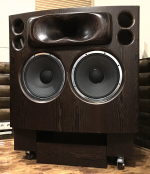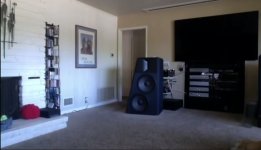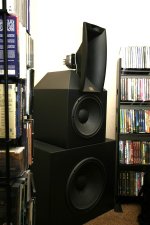Can you elaborate? You only mean this is in the most literal sense.... Fairly neutral has been around since Genelec came around, but I guess that has no bearing on final voicing in the studio.Flat response speakers have rarely been used in music production environments throughout history.
Yes, but it takes some "want to" to get there... Whole Spectrum and High SPL has to be specified since they mean different things to different people... With a large woofer in a vented cabinet mated to a Large compression driver on a large waveguide you can do pretty well from 30hz and up. I am building something more fun and ambitiousIs it possible to cover the whole spectrum, high spl, low distortion with a 2-way ?
Now, at 700 pages with 14000 posts and without reading everything :
Is it possible to cover the whole spectrum, high spl, low distortion with a 2-way ?
The limit is around 17-23kHz, if 115dB is loud enough.
NoNow, at 700 pages with 14000 posts and without reading everything :
Is it possible to cover the whole spectrum, high spl, low distortion with a 2-way ?
Even 90 years ago, the ojective of the thread title was almost achieved by the Fletcher system (35-15 kHz).
A limiter was used (around 100 dB) to protect the hearing of the audience, but the system could easily reach >120 dB.


A limiter was used (around 100 dB) to protect the hearing of the audience, but the system could easily reach >120 dB.
Greg Timbers:
"My system consists of two 15" Alnico woofers with 1" long voice coils in a 1.5" long magnetic gap. The cones are a foam core substrate with paper skins. The woofers are immensely linear and vanishing low in distortion. The HF compression driver uses a 4" Neodymium magnetic circuit with a one-piece 4" pure beryllium diaphragm and surround. The first breakup mode of this diaphragm is around 15 kHz. The UHF driver is a miniature version of the big driver. It uses a 1" diaphragm. Both horns are of the constant directivity nature meaning that their pattern is constant with frequency. The enclosure is around 280 litres and constructed of multiple layers of curved, cored out, and foam filled MDF. It is extensively braced and the upper front baffle actually forms two of the horn surfaces.
The two LF drivers are "combined" into a single driver with the outboard woofer having an active analog 6 dB crossover at about 180 Hz. The HDP4 treats this combination as a single LF driver. The crossovers are 48dB/octave linear-phase at 750 Hz and again at 12 kHz. The completed system has essentially flat response from 20 Hz up to a measured 40 kHz. It should go to about 60 kHz but I can't measure it and the digital signals quit around 48 kHz."
As far as I know he disconnected the tweeters, because he prefers the DD67000s in 2.5 way mode.

"My system consists of two 15" Alnico woofers with 1" long voice coils in a 1.5" long magnetic gap. The cones are a foam core substrate with paper skins. The woofers are immensely linear and vanishing low in distortion. The HF compression driver uses a 4" Neodymium magnetic circuit with a one-piece 4" pure beryllium diaphragm and surround. The first breakup mode of this diaphragm is around 15 kHz. The UHF driver is a miniature version of the big driver. It uses a 1" diaphragm. Both horns are of the constant directivity nature meaning that their pattern is constant with frequency. The enclosure is around 280 litres and constructed of multiple layers of curved, cored out, and foam filled MDF. It is extensively braced and the upper front baffle actually forms two of the horn surfaces.
The two LF drivers are "combined" into a single driver with the outboard woofer having an active analog 6 dB crossover at about 180 Hz. The HDP4 treats this combination as a single LF driver. The crossovers are 48dB/octave linear-phase at 750 Hz and again at 12 kHz. The completed system has essentially flat response from 20 Hz up to a measured 40 kHz. It should go to about 60 kHz but I can't measure it and the digital signals quit around 48 kHz."
As far as I know he disconnected the tweeters, because he prefers the DD67000s in 2.5 way mode.
My "concept" PrimeRadiant (drivers in-hand total $300) Fostex 15W300 x 2 (possibly different bass tuning, and low-pass one up-firing or push-pull behind the other) with ceramic button-tweeters in a ring bouncing off of convex-reflector-over-dustcap. Half-space-omni-directional time-and-phase-aligned virtual point-source. Strictly speaking not 2-way?Now, at 700 pages with 14000 posts and without reading everything :
Is it possible to cover the whole spectrum, high spl, low distortion with a 2-way ?
Last edited:
Even 90 years ago, the ojective of the thread title was almost achieved by the Fletcher system (35-15 kHz).
A limiter was used (around 100 dB) to protect the hearing of the audience, but the system could easily reach >120 dB.
View attachment 1440714View attachment 1440715
Re: Wente & Thuras 60° by 120° equal-loudness double-horn near-point-source
I have extended the reflector point-source proof-of-concept to multiple-tweeter configurations, in order to better match the high sensitivity and SPL potential of large Pro/PA loudspeaker drivers. I now have nine different 15" widebands including (once) industry standards Peavey Scorpion and Black Widow, Fostex 15W300, JBL 2226H etc. Of course, the tweeter assembly and convex reflector should be "bridge" mounted and physically isolated from the cone and dustcap; unnecessary near-field unless playing deep bass loud. I think this experimental "speaker" to a large extent is able to mimick the...
Last edited:
... and the Doppler discussion below this is highly relevant.
Yes, In the late seventies-early eighties, a lot of testing. With a 3-way system (xo at ~450-3500Hz) the sound space was nice wide and deep and perspective appeared normal, that is a vanishing point, simply put, the further away the smaller.
With 2-way, xo at 1750Hz, this perspective sort of inversed. The further away the wider but also more vague/cloud instead of point. So the inverse of a vanishing point. For pop-music it was most of the time nice, for classical or jazz the recording mostly also has the space recorded, and that did not reproduce the spaciousness as you would expect. Not...
With 2-way, xo at 1750Hz, this perspective sort of inversed. The further away the wider but also more vague/cloud instead of point. So the inverse of a vanishing point. For pop-music it was most of the time nice, for classical or jazz the recording mostly also has the space recorded, and that did not reproduce the spaciousness as you would expect. Not...
As far as i know, he took apart his DD67000 eventually.As far as I know he disconnected the tweeters, because he prefers the DD67000s in 2.5 way mode
As for running without the 045be in the DD6700 and the other top end JBL consumer products, notice how it is implemented also.
His own horn design, 2,5 way with woofers vertical in a slanted design ala 250ti etc., run through DEQX also.
See Erins audio corner interviews for some detail.
Attachments
Last edited:
What horn is used in the rendering? It is similar to one of my designs.Can you elaborate? You only mean this is in the most literal sense.... Fairly neutral has been around since Genelec came around, but I guess that has no bearing on final voicing in the studio.
Yes, but it takes some "want to" to get there... Whole Spectrum and High SPL has to be specified since they mean different things to different people... With a large woofer in a vented cabinet mated to a Large compression driver on a large waveguide you can do pretty well from 30hz and up. I am building something more fun and ambitious
View attachment 1440710
As far as i know, he took apart his DD67000 eventually.
The last time I was laid off (due to the credit crises in 2008), I was treated much more respectfully than Greg Timbers, who spent 43 years of his life at JBL.
I had only been with that specific company for 6 months (but received full salary for the rest of the year, including use of the company car).
It's a good ol' diffraction horn:
Last edited:
Greg apparently likes live music and wide dispersion.
Diffraction horns are acceptable for that purpose, but even the most advanced smooth diffraction horns, such as the 18 Sound XR1496, fail miserably to adequately 'portray' solo singer-songwriters, small acoustic bands with a vocalist, solo instrumental music, and the like.
Granted, the listening distance also plays a role.
Diffraction horns are acceptable for that purpose, but even the most advanced smooth diffraction horns, such as the 18 Sound XR1496, fail miserably to adequately 'portray' solo singer-songwriters, small acoustic bands with a vocalist, solo instrumental music, and the like.
Granted, the listening distance also plays a role.
Last edited:
They don't fail, they sum further away, so if you sit to close you don't have the tweeter and woofer aligned right. WIth a dome the listening distance can be much closer than with a CD in horn. But on the right distance a CD in horn is a lot better i think.Greg apparently likes live music and wide dispersion.
Diffraction horns are acceptable for that purpose, but even the most advanced smooth diffraction horns, such as the 18 Sound XR1496, fail miserably to adequately 'portray' solo singer-songwriters, small acoustic bands with a vocalist, solo instrumental music, and the like.
Granted, the listening distance also plays a role.
What you're referring to is not typical of diffraction horns, it's something related to sound sources in general.
With diffraction horns the apparent apices do not occur at the same point on the axis, which negatively affects the curvature of the wavefront.
This phenomenon is called astigmatism (it's been a long time since I last used that term).
Astigmatism also occurs in optical systems when rays that propagate in two perpendicular planes have different foci. This causes abberation > defocus.
Most diffraction horns also suffer from additional distortion components.
With diffraction horns the apparent apices do not occur at the same point on the axis, which negatively affects the curvature of the wavefront.
This phenomenon is called astigmatism (it's been a long time since I last used that term).
Astigmatism also occurs in optical systems when rays that propagate in two perpendicular planes have different foci. This causes abberation > defocus.
Most diffraction horns also suffer from additional distortion components.
Enlightning term. I never liked diffraction horns, even from the time I was not at all interested in horns. Those horns sounded always harsh to me.This phenomenon is called astigmatism (it's been a long time since I last used that term).
If anyone wants to build a similar TMM as Timbers' system - or possibly an MTM, but a bit smaller without the need for separate subs.
Someone sells these 1" EAW horns on 'the bay', which are very good.
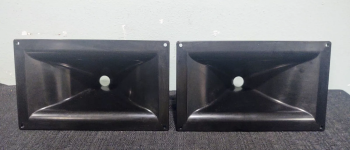
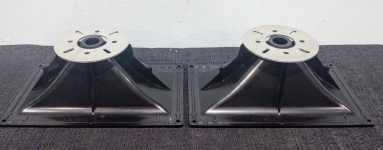
Normally this horn is used in combination with a 12 or 15" woofer.
Instead, I would use 2x B&C 8NDL51, the 16 Ohm variant, for a BR cab of 120, but preferably 150 liters.
Someone sells these 1" EAW horns on 'the bay', which are very good.


Normally this horn is used in combination with a 12 or 15" woofer.
Instead, I would use 2x B&C 8NDL51, the 16 Ohm variant, for a BR cab of 120, but preferably 150 liters.
Last edited:
it IS one of your horns, just used for an Example, not shared with anyone anywhere.What horn is used in the rendering? It is similar to one of my designs.
Greg apparently likes live music and wide dispersion.
Diffraction horns are acceptable for that purpose, but even the most advanced smooth diffraction horns, such as the 18 Sound XR1496, fail miserably to adequately 'portray' solo singer-songwriters, small acoustic bands with a vocalist, solo instrumental music, and the like.
Granted, the listening distance also plays a role.
That's your opinion. My 1400 Arrays do this quite well. For this to work you need the slot vertical not horizontal. As portrayed in pictures of Greg's systems.
Rob 🙂
Attachments
Now, at 700 pages with 14000 posts and without reading everything :
Is it possible to cover the whole spectrum, high spl, low distortion with a 2-way ?
It depends ........ 😉
- Home
- Loudspeakers
- Multi-Way
- Is it possible to cover the whole spectrum, high SPL, low distortion with a 2-way?
